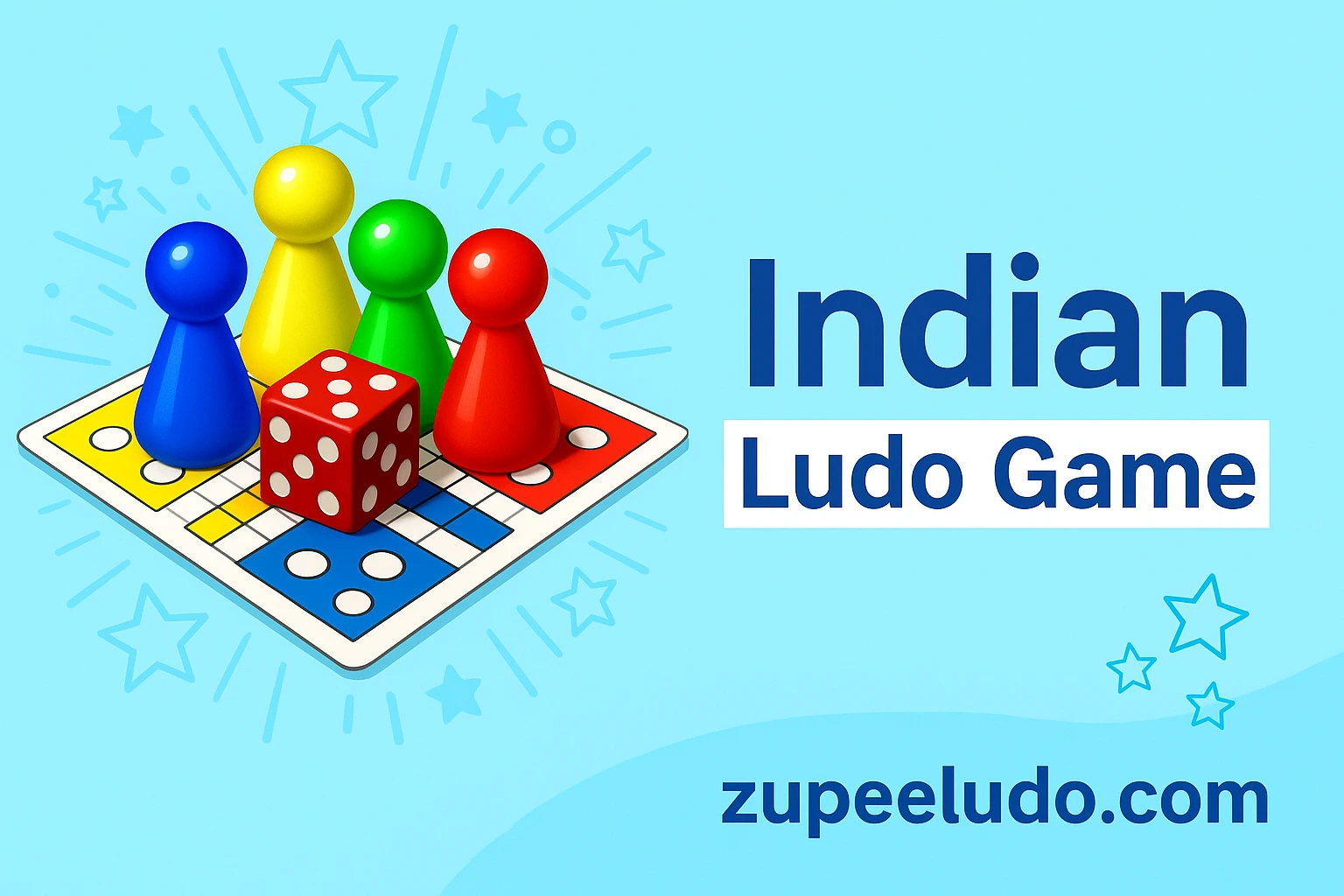The Indian Ludo game has a rich and fascinating history that dates back centuries. Originating from the royal courts of ancient India, it has transformed from Pachisi, a traditional game played on cloth boards, into a vibrant digital game enjoyed by millions worldwide. Today, Indian Ludo is not only a source of entertainment but also a symbol of nostalgia and togetherness.
In this detailed post, we’ll explore how the Indian Ludo game has evolved over time — from ancient roots to modern apps like Zupee, Ludo Supreme, and Ludo Ninja — and why it continues to be one of the most loved games in India.
What is Indian Ludo?
Indian Ludo is the modern version of the traditional Indian board game called Pachisi. With simplified rules and a colorful design, Ludo quickly became popular in Indian households. The objective is simple yet strategic: move all your tokens (called “goti”) around the board and bring them safely to the home area.
This game combines luck (dice rolls) with strategy (token movement). Its engaging format and family-friendly appeal have made it a staple of both childhood memories and adult game nights.
The Origin: From Pachisi to Ludo
The journey of Indian Ludo began with Pachisi, a game believed to be invented in 6th century India. Played with cowrie shells and cross-shaped boards, Pachisi was a game of strategy, patience, and luck.
🏛️ Played by Indian Royalty
Historical records suggest that Mughal emperors such as Akbar played Pachisi using life-sized boards and human tokens in royal courtyards. This shows the prestige and cultural importance of the game in ancient times.
🌍 Global Adaptation
When the British came to India, they adapted Pachisi into a simplified version called Ludo, which they later patented in 1896. The square board, single die, and color-coded tokens were introduced, making the game easier for mass audiences.
How to Play Indian Ludo Game
Understanding how to play Indian Ludo is crucial to enjoying it. Here’s a breakdown of its gameplay:
1. Setting Up the Game
- The game is for 2 to 4 players.
- Each player chooses one of four colors: Red, Green, Yellow, or Blue.
- Every player gets four gotis (tokens).
- A single die is used to determine moves.
2. Movement of Tokens
- You must roll a six to bring a token onto the board.
- Tokens move clockwise based on the dice roll.
- The goal is to complete a full loop and reach the center home triangle.
- Safe zones (usually marked) prevent your goti from being cut by opponents.
3. Cutting and Scoring
- If your goti lands on an opponent’s goti (outside safe zones), the opponent’s goti is sent back to the start.
- Cutting a goti sometimes earns an extra turn.
- The first player to bring all four tokens to the home area wins.
Indian Ludo Board Layout
The Indian Ludo board is divided into four quadrants, each dedicated to one player. Each quadrant contains a starting area, colored path, and final home stretch.
Important Board Elements:
- Home Column: Final colored path to the center.
- Safe Squares: Marked boxes where tokens can’t be cut.
- Center Home: The goal for all tokens.
The Popularity of Indian Ludo
Indian Ludo is more than a game — it’s a cultural phenomenon. Whether it’s Diwali family gatherings or casual evenings with friends, Ludo brings people together.
Why It’s Still Popular:
- Simple rules that even kids can understand.
- Family bonding through shared fun.
- Strategic gameplay that keeps adults engaged.
- Nostalgia from childhood memories.
The Rise of Indian Ludo Game Apps
With the rise of smartphones, Ludo has entered the digital era. Indian developers have created exciting new formats of the traditional game with real-money rewards, leaderboards, and online multiplayer.
Top Indian Ludo Game Apps
1. Zupee
Zupee is one of the most popular Indian Ludo platforms offering real cash prizes and fast-paced Ludo games.
Zupee’s Ludo variations:
- Ludo Supreme – Score-based, time-limited.
- Ludo Supreme League – Compete in leagues and win rewards.
- Ludo Ninja – Dice-less, predictive play.
- Ludo Turbo – Fastest version with a time-limited move system.
2. Ludo King
Another famous app, Ludo King retains the classic feel while offering online gameplay with friends and strangers.
3. Ludo Empire & MPL Ludo
Real-money apps where strategic play can earn you actual cash.
Zupee Ludo Variants Explained
✅ Ludo Supreme
- Time-based game (under 10 minutes).
- Points are scored for each goti movement.
- Highest scorer at the end wins.
✅ Ludo Ninja
- No dice involved.
- Players see the sequence of numbers beforehand and must plan accordingly.
- Encourages strategic planning over luck.
✅ Ludo Turbo
- Every move is time-bound.
- Great for fast thinkers who love adrenaline-filled rounds.
✅ Ludo Supreme League
- Join a tournament.
- Score to climb the leaderboard and win cash prizes.
Why Play Indian Ludo Online?
1. Play Anytime, Anywhere
Whether at home or during commute, enjoy the game on your smartphone.
2. Real Money Rewards
Apps like Zupee let you play Ludo to win real cash legally.
3. Multiplayer Fun
Play with friends or new opponents from across India and the world.
4. New Game Modes
Unlike traditional board Ludo, modern apps offer unique versions to avoid monotony.
5. Skill + Strategy
Modern Ludo apps are not just about luck. Many involve planning and prediction, making them more engaging.
Is Ludo a Game of Skill or Luck?
This is often debated. Traditional Ludo relies heavily on dice rolls (luck), but new-age formats like Ludo Ninja or Supreme involve scoring strategies and prediction. In fact, platforms like Zupee have labeled their games as “games of skill”, which are legally allowed under Indian gaming laws.
Indian Ludo vs Pachisi – What’s the Difference?
| Feature | Pachisi | Ludo |
|---|---|---|
| Board Shape | Cross-shaped | Square-shaped |
| Dice | Cowrie shells | 1 Standard Die |
| Players | 2–6 | 2–4 |
| Complexity | High | Medium |
| Digital Version | No | Yes |
Indian Ludo: Frequently Asked Questions (FAQs)
❓ What is Indian Ludo?
It’s a simplified version of Pachisi, a game native to India, played with dice and tokens.
❓ What is Indian Ludo called in Hindi?
It’s commonly known as “Chaupar” or “Pachisi” in traditional terms.
❓ Where did Indian Ludo originate?
It originated in India, dating back to the 6th century.
❓ Are there variants of Ludo in India?
Yes, from Chaupar to Ludo King, Zupee Ludo, and Ludo Ninja, many formats exist today.
❓ What is the best Ludo app in India?
Zupee is considered one of the best due to its competitive formats and real-money games.
Conclusion
The Indian Ludo game has traveled a long and fascinating journey — from the royal palaces of ancient India to the touchscreens of modern smartphones. Whether you’re playing a classic version with family or testing your skill in real-money Ludo games on apps like Zupee, the charm of Ludo remains timeless.
Its blend of strategy, luck, and social interaction makes Ludo an evergreen game that bridges generations. So next time you roll the dice, remember — you’re not just playing a game, you’re part of a cultural legacy.


